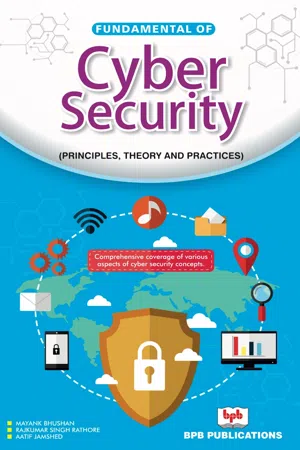
Fundamentals of Cyber Security
Principles, Theory and Practices
Mayank Bhushan
- English
- ePUB (apto para móviles)
- Disponible en iOS y Android
Fundamentals of Cyber Security
Principles, Theory and Practices
Mayank Bhushan
Información del libro
Learn the various aspects of Cyber Security concepts. Key Features
- Strengthens the foundations, as detailed explanation of the concepts are given.
- Simple language, crystal clear approach, straight forward comprehensible presentation.
- Adopting user-friendly classroom lecture style.
- The concepts are duly supported by several examples.
- Previous years question papers are also included.
- The important set of questions comprising of more than 90 questions with short answers are also included.
Description
The book has been written in such a way that the concepts are explained in detail, giving adequate emphasis on examples. To make clarity on the topic, diagrams are given extensively throughout the text. Various questions are included that vary widely in type and difficulty to understand the text. This text is user-focused and has been highly updated including topics, pictures and examples.
The book features the most current research findings in all aspects of information security. From successfully implementing technology change to understanding the human factors in IT utilization, these volumes address many of the core concepts and organizational applications, implications of information technology in organizations. What You Will Learn
- Information Systems, Information Security, Security Policies and Standards
- Application Security, Security Threats
- Development of secure Information System
- Security Issues In Hardware
-
Who this book is for
Students, Programmers, researchers, and software developers who wish to learn the basics and various aspects of cybersecurity. Table of Contents
1. Introduction to Information Systems
2. Information Security
3. Application Security
4. Security Threats
5. Development of secure Information System
6. Security Issues In Hardware
7. Security Policies
8. Information Security Standards About the Author
Mayank Bhushan has completed his M.Tech. from Motilal Nehru National Institute of Technology Allahabad. He has 7 years of experience in academics. Rajkumar Singh Rathore is working as Assistant Professor in Computer Science and Engineering Department at Galgotias College of Engg. & Technology, Greater Noida (U.P.). Aatif Jamshed is working as Assistant Professor in Computer Science and Engineering Department at Galgotias College of Engg. & Technology, Greater Noida (U.P).
Preguntas frecuentes
Información
Chapter-1
Introduction to Information Systems
1.1 INTRODUCTION
1.2 MODELLING THE BUSINESS METHOD

1.2.1 Business Profile, Model and Process


1.3 INFORMATION SYSTEM COMPONENTS


- Hardware Hardware is the physical embodiment of an information system. It is one of the main elements which creates the information system cycle.

Type of Hardware | Functions | Examples |
Input | Giving data input to the system. | Keyboard, mouse, pointer, screen, touch ball and scanner. |
Processing | Operating the computer system. | Central processing unit and memory. |
Output | Can display results or output which are generated from the computer system. | Screen, microphone and printer. |
Storage | For storing data inside the computer. | Hard disk, floppy disk, CD-ROM and magnetic tape. |
- Software system Software consists of two classes a the system software system and therefore the application software.- System software system controls the laptop and contains the software system and device drivers, which may communicate with the hardware. It also can change information into a replacement kind, stop viruses and create copies.- Application software system contains programs that will help users and change corporations to (do/complete) business functions. Users will increase working well and getting a lot done with the presence of application software system like spreadsheets, data processing, ordering systems, and (money owed to you).
- Data Data refers to the raw facts on anything or things/businesses like student names, courses and marks. The raw data that has not yet been given can be Processed to become more useful information.
Índice
- Cover Page
- Title Page
- Copyright Page
- Dedication
- Preface
- Acknowledgement
- Table of Contents
- Chapter-1 Introduction to Information Systems
- Chapter-2 Information Security
- Chapter-3 Application Security
- Chapter-4 Security Threats
- Chapter-5 Development of secure Information System
- Chapter-6 Security Issues In Hardware
- Chapter-7 Security Policies
- Chapter-8 Information Security Standards
- Important Questions
- Previous Years University Question Papers
- References